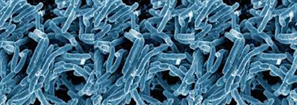Please click the frequently asked questions below for further information and IPC precautions required:
-
What is Nontuberculous mycobacteria (NTM)?
Nontuberculous mycobacteria (NTM) are mycobacteria which do not cause tuberculosis or leprosy. NTM infections are most frequently located in the lungs, but may also be found in lymph nodes, skin, soft tissue, joints and bones.
NTM comprise a multispecies group of organisms common throughout the environment and are rarely associated with outbreaks in care settings.
Fifteen species are recognized as pathogenic to humans, with some species showing high levels of antimicrobial resistance particularly M. abscessus.

-
Why is this information important?
If NIAS staff are aware that the patient is potentially symptomatic or a confirmed case of Nontuberculosis mycobacteria then this should be communicated to EAC / NEAC and communicated to the receiving unit when transferring the patient to ensure effective patient care and management.
-
How is it spread?
NTM is not considered contagious and is spread via environmental sources, typically water, but also contaminated medical equipment/devices.
M. abscessus: Healthcare-associated infections due to this bacterium are usually of the skin and the soft tissues under the skin, which usually become red, warm, tender to touch, swollen, and/or painful. Infected areas can also develop boils or pus-filled vesicles. M. abscessus is also a cause of serious lung infections in persons with chronic lung diseases, such as cystic fibrosis. Infection with M. abscessus is usually caused by injections of substances contaminated with the bacterium or through invasive medical procedures employing contaminated equipment or material. Infection can also occur after accidental injury where the wound is contaminated by soil.
M. avium and M. fortuitum have been linked to hot tubs or spa baths, with NTM found in spa bath water and/or in the air of the homes of the people diagnosed with NTM infection. Infection may occur in the skin or soft tissues following trauma or surgery.
M. chimaera which belongs to the M. avium complex, has been recognised as a cause of endocarditis, severe disseminated infection and chronic sternal wound infection in patients who have undergone cardiothoracic surgery. This is likely to be transmitted from the heater cooler units of cardiopulmonary bypass equipment. M. chimaera may manifest many years after surgery.
Vulnerable groups include HIV infected and immunocompromised persons, cystic fibrosis (CF) patients, and those who have had open heart surgery since January 2013.
-
What are the symptoms of NTM?
NTM cause pulmonary diseases that resemble tuberculosis: symptoms may include:
- Fever
- Tiredness
- Nausea/vomiting
- Night sweats
- Cough
- Weight loss
The more severe cases requiring antibiotic and steroid therapy.
-
IPC Precautions
- Standard Precautions should be used.
- Hand Hygiene should be completed as per the 5 moments in line with usual practice.
- Eye protection should be risk assessed and worn if there are any concerns regarding a droplet or splash risk.
- Gloves and Aprons should be risk assessed.
- Laundry should be treated as per standard precautions and disposed of in line with the local protocol.
-
What cleaning is required?
All equipment and the ambulance should have an in-between patient clean, paying particular attention to touch points.
-
Do staff need any prophylaxis or follow up?
Staff do not need follow up or prophylaxis.




